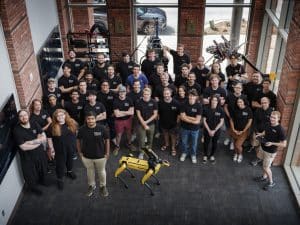IHMC honored by Humanoid Robotics Technology as Outstanding Research Organization
The Florida Institute for Human and Machine Cognition (IHMC) is once again in the international spotlight in the field of humanoid robotics.
The Institute was named Outstanding Research Organization in the 2025 Humanoid Robotics Industry Awards for its Nadia humanoid project. The awards are sponsored by Humanoid Robotics Technology (HRT) in partnership with Novanta.
Dr. Morley Stone, IHMC’s Chief Executive Officer, was thrilled that the team was recognized in this way — among competition such as the University of California at San Diego, Massachusetts Institute of Technology, the University of California at Berkley, Standford University, Shanghai Tech University, the Instituto Italiano di Tecnologia, Harbin Institute of Technology, Peking University, and ETH Zurich.
“IHMC is indeed a special place, where researchers work together across numerous disciplines every day to push the envelope in terms of what is possible in humanoid robotics and teaming,” Stone says. “To have the worldwide humanoid community recognize us and our work is an honor.”
Humanoid Robotics Technology is a website dedicated to industry news in humanoid robotics. The Outstanding Research Organization Award honors organizations that deliver research that significantly advances the field, includes community engagement and outreach to raise awareness of the benefits of humanoids in society, and pioneer new humanoid platforms, says Jack Hallewell, co-founder of HRT.
Nadia’s range of motion and high power-to-weight ratio is one of the design elements that makes the humanoid unique in the field. The robot’s namesake is famed gymnast Nadia Comăneci, as a nod to the ultimate design goal — achieving human-range-of-motion. IHMC’s Nadia gained internet notoriety in for videos showing her boxing and playing ping pong.
The HRT team said of Nadia and IHMC in the nomination:
Researchers at IHMC developed Anticipatory and Adaptive Footstep Streaming for Teleoperated Bipedal Robots. It retargets user steps to robot footstep locations, allowing the robot to utilise its own dynamics for locomotion, ensuring better balance and stability. The method anticipates user footsteps to minimise delays between when the user initiates and completes a step and when the robot does it. Additionally, the system autonomously adjusts the robot’s steps to account for its surrounding terrain, overcoming challenges posed by environmental mismatches between the user’s flat-ground setup and the robot’s uneven terrain.
“It’s a deep honor to have our Nadia project be recognized in this way,” says Senior Research Scientist Dr. Robert Griffin, who leads the robotics team at IHMC. “IHMC has always prided itself on its research contributions to the field and watching the evolution of humanoids as a discipline and industry from the time Nadia started in 2018 and 2019 to 2025 has been nothing short of astonishing.”
“We’re quite excited for the recognition of our project’s contribution to this revolution and are excited to see what the future holds, both for humanoids at large and for our future contributions to the field.”
The Nadia platform, which was retired in the fall of 2025 to make way for IHMC’s next generation platform named Alex, aimed to develop highly mobile ground robots that can function in indoor environments where stairs, ladders, and debris would require the same range of motion as a human.
As mentioned, Alex, IHMC’s next iteration humanoid, is under development supported by funding from the U.S. Office of Naval Research. The research goals for Alex include design and integration of next-generation controllers for outdoor urban operations, enhanced design of behaviors for building exploration, integration of a behavior cloning pipeline, and improved simulation environment.
The aim is for Alex and its successors to be robust and yet nimble enough to operate in operational environments where the risk to human responders is high, from military scenarios to disaster response.
In the winners’ announcement, Hallewell congratulated those recognized for advancing the field of humanoid robotics. “We’re proud to be part of this exciting journey and inspired by the ongoing achievements of the humanoid robotics community,” he said.
IHMC is a not-for-profit research institute of the Florida University System where researchers pioneer science and technology aimed at leveraging and extending human capabilities. IHMC researchers and staff collaborate extensively with the government, industry and academia to help develop breakthrough technologies. IHMC research partners have included: DARPA, the National Science Foundation, NASA, Army, Navy, Air Force, National Institutes of Health, IBM, Microsoft, Honda, Boeing, Lockheed, and many others.
Latest News
- STEM-Talk: NASA’s Flawed Plan to Return to the Moon – with Mike Griffin and Lisa Porter
- IHMC partners with Conduit Venture Labs to accelerate commercialization efforts
- Research platforms aim to better support military personnel in high-stress environments
- Study for U.S. Air Force Research Lab tracks impact of ketones on pilot ventilation
- National Institute on Aging funded study tracks changes to gait as we age
- Meet Alex, IHMC’s next generation humanoid robot
- Decades of AI-expertise fuel growth of National Center for Collaborative Autonomy
- Entrepreneurs, researchers find opportunity at Northwest Florida Pitch Day
- IHMC honored by Humanoid Robotics Technology as Outstanding Research Organization


